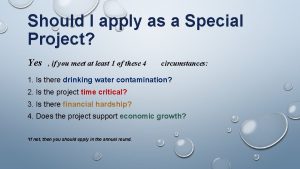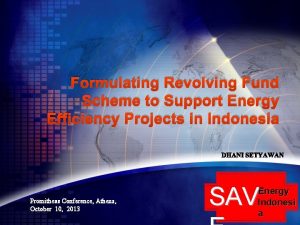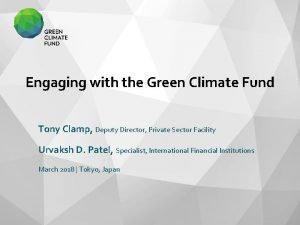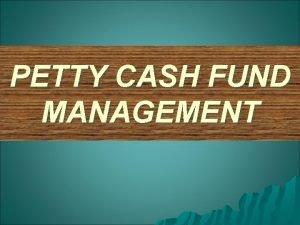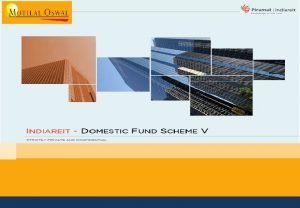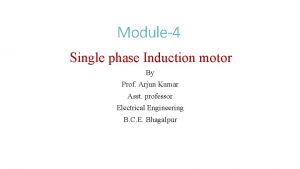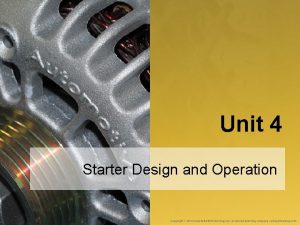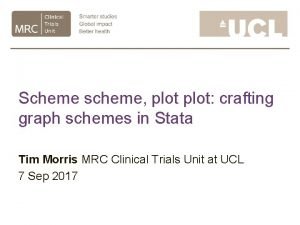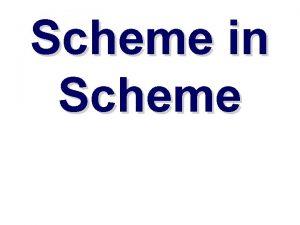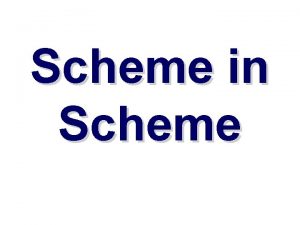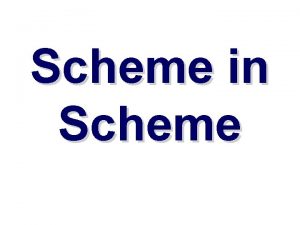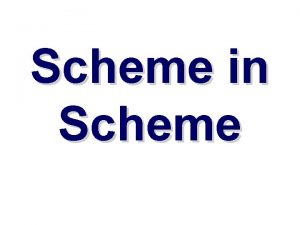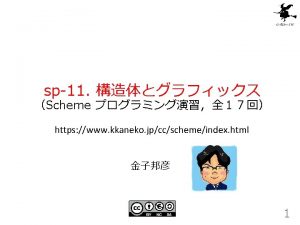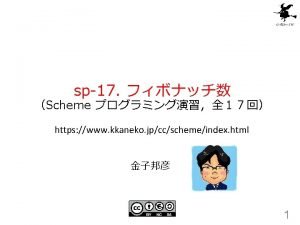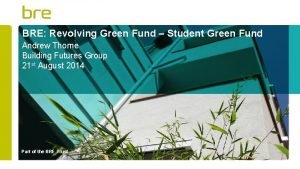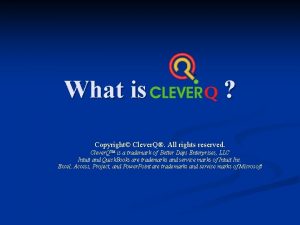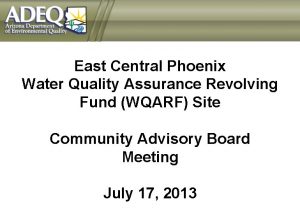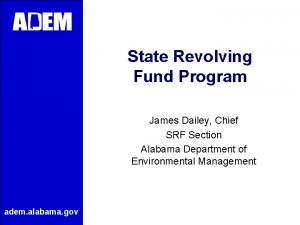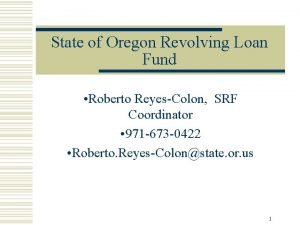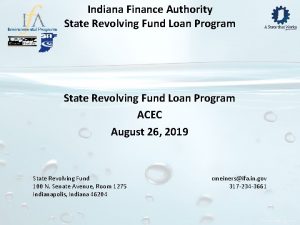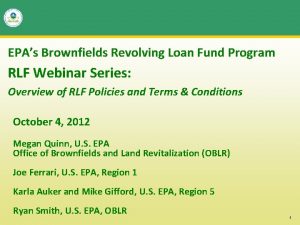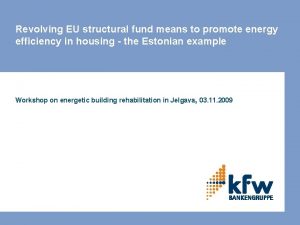Clever Climate Economics A Solar Revolving Fund Scheme



























- Slides: 27

Clever Climate Economics A Solar Revolving Fund Scheme for Local Councils

How the CORENA model works • Donations (crowdfunding) provide ‘free capital’ • CORENA gives interest-free loans to NFP community organisations for solar and energy efficiency projects • Loans are repaid using the savings on a recipient’s energy bills – recipient is never out of pocket • Quarterly loan repayments return to a revolving fund • Loan repayments + new donations fund new projects The solar panels ‘pay for themselves’

CORENA revolving fund model Key Point: The donated money is never ‘used up’. At any point most of the funds are ‘tied up’ in solar projects, but each quarter loan repayments are returned to the revolving pool and are used again and again to achieve yet more reductions in carbon emissions.

In first 5 years CORENA has. . . • Raised $177, 000 in donations to solar projects • Given interest-free loans to NFPs for 23 solar and energy efficiency projects • Put $133, 000 in loan repayments back into the revolving fund and re-used those funds • Provided $310, 000 worth of solar projects (202 k. W) from $177, 000 in free capital ← ethical capitalism • Avoided 496 MWh of grid usage, reducing carbon emissions by roughly 446 tonnes (as of July 2018) This amounts to an ROI of 75% *1: MWh and CO 2 figures grow every day, and would continue to grow for the next 25 years even if we stopped funding new projects right now.

Scaling it up If a non-profit group can do this via donations, with no paid staff and almost no admin budget, just imagine. . . how much more could a body with access to a LOT more ‘free’ capital achieve? How much could a climate-conscious local council achieve?

Combining the best of both worlds CORENA • Very cost-effective reductions in carbon emissions • Capital is never ‘used up’ • Recipients end up with ‘free’ solar • • Local councils Access to MUCH more capital No GST payable Bulk buy prices Economies of scale

Darebin Council ‘Solar Savers’

Solar Savers model Solar Savers is a type of solar revolving fund used by Darebin, Adelaide and some other Councils. • Council funds the scheme via a low-interest loan • Suppliers submit tenders (bulk-buy prices) that meet high quality and warranty requirements • Homeowners 1 pay Council for their solar installations via a special charge over 10 years • Solar recipients get generous immediate savings and ultimately ‘free’ solar that has paid for itself *1: Includes landlords of rented properties. The tenants get the savings benefit, but the landlord can charge a slightly higher rent next time the property is rented out.

Does your Council want to. . • Model climate responsibility and empower your community to reduce their carbon emissions? OR • Help disadvantaged householders to reduce their electricity costs? OR • A bit of both? Council can set various cost parameters to design a solar scheme that best suits your aim(s).

Parameter 1: Cost of capital CORENA uses free (donated) capital but Councils generally will take out a low-interest loan. • Darebin CC covers the cost of the interest for pensioners and non-profits, but not for others. • Adelaide CC passes on the cost of interest. • With a CORENA style revolving fund, the repayments from solar recipients can be used again and again to fund future rounds of the solar scheme. If Council passes on the interest cost to all solar recipients, in effect Council is using ‘free’ capital (the scheme becomes self-funding).

Parameter 2: GST • CORENA solar recipients pay GST on solar installations but no interest on their solar loan. • Darebin CC pays the solar supplier, including the GST, but can claim back the GST. Over the payback term, householders only pay Council the GST-free cost of the solar installation. • Since solar recipients are paying 10% less than normal under the Solar Savers model, Council can easily pass on the capital cost (interest cost) to householders. Note: Solar PV will ‘pay for itself’ quite quickly even if the cost to them includes both GST and interest.

Parameter 3: Payback term • CORENA payback term is as short as possible while ensuring that savings on bills still cover loan repayments. • Darebin and Adelaide both set 10 -year terms even though in Adelaide (but not Melbourne) solar often pays for itself in 5 years or less. • A 5 -year term will give twice as much reduction in carbon emissions from any given amount of funding compared with a 10 -year term because the funds can be used twice in 10 years. Council might consider a longer term for pensioners, for example, but set a reasonably short payback term for others in order to reduce climate risk most cost-effectively.

Setting a reasonable payback term • Actual time for solar to ‘pay for itself’ varies greatly in different states due to differing solar prices, electricity prices, solar radiation, and feed-in tariffs. • The ‘pay for itself’ time is shorter for larger systems and higher onsite (daytime) use, meaning for some households the payback time will be considerably shorter than the payback term set by Council. • If Council wants to set a standard payback term that works well for all solar recipients, Council could set the following payback terms: 5 year payback: Adelaide, Brisbane, Canberra, Perth, Sydney 7 year payback: Darwin, Melbourne 8 year payback: Hobart See the Appendices for indicative costings for each city.

Parameter 4: Solar installation size • Generally small solar installations cost a lot more than larger ones. The best k. W/$ figures are for either 5 k. W or 10 k. W. • For householders Darebin CC offers either 3, 4 or 5 k. W options. Even 3 k. W might generate more electricity than some households use during the day, but anything smaller is not cost-effective. • For cost-effectiveness, Darebin CC encourages householders to select a 5 k. W system if it will fit on their roof. If a householder has low daytime electricity usage and installs 5 k. W of solar, their savings on power bills might not be enough to cover the payments to Council over a 5 -8 year term. However, if immediate savings are not so important to a householder, they might choose 5 k. W for the sake of greater reductions in carbon emissions. Over the lifetime of the system a 5 k. W installation will save householders a lot more than a 3 k. W solar installation.

Parameter 5: Quality and warranties • CORENA insists on top-quality panels and inverters, accredited installers, and the best available warranties from reputable companies for their solar projects. • Darebin CC also insists on the above when selecting from the tenders for their Solar Savers model. This is crucial for maintaining trust in the scheme. A real barrier to householders installing solar is not knowing who to trust to give them a quality system. A very real drawcard of the CORENA and Solar Savers models is that solar recipients have confidence that they are getting a top-quality system, so don’t be tempted to choose cheaper options. Even expensive panels will ‘pay for themselves’ quite quickly!

Suggested messaging ü Council is enabling residents to reduce their carbon footprint at no cost to the householder/business. ü Savings on electricity bills pay back the solar cost to Council over [number] years. ü Short-term savings might be minimal, but after payback the savings will be substantial. ü From Day 1 your solar installation will be reducing carbon emissions, which benefits everyone. Council’s solar scheme empowers ALL householders to be climate good guys!

Finally. . . what will you call the scheme? • CORENA calls its scheme Quick Win projects – Focus is on the clever climate economics. Solar panels ‘pay for themselves’, giving ‘free’ solar and ‘free’ carbon reduction (without ever depleting the revolving funds). • Darebin CC calls its scheme Solar $avers (with a dollar sign) – Switches the focus to dollars and encourages householders to expect significant and immediate savings rather than just a quality solar installation that ultimately costs them nothing. • Possible names – – – Solar Champions Solar for Everyone 100% solar for [council area name] Solar Savers: Saving the planet & saving on bills ? ? ?

Key points • Solar PV quite literally ‘pays for itself’. • A revolving fund provides the temporary capital required, with no impost on ratepayers if you pass on the interest cost to solar recipients. • The only cost to Council is the work-hours to set up the solar revolving fund scheme. EVERY household in your area could have solar at no cost to themselves!

Thank you for your time! For more information see: • CORENA Quick Win solar scheme: https: //corenafund. org. au/quick-win-projects/ or email admin@corenafund. org. au • Darebin Solar Savers: http: //www. darebin. vic. gov. au/en/Darebin-Living/Caring-for -the-environment/Energy. Climate or email solar@darebin. vic. gov. au or phone Darebin Council on (03) 8470 8888 • Adelaide Solar Savers: https: //www. cityofadelaide. com. au/yourcouncil/funding/solar-savers-adelaide/ FAQ: https: //yoursay. cityofadelaide. com. au/solarsavers/faqs#question 23626 or email solarsavers@cityofadelaide. com. au • The Excel sheet mentioned in the Appendices is available from admin@corenafund. org. au

Appendix 1: Sydney indicative figures • • • With solar PV cost shown in apricot cells (includes paying GST) 4% interest added to payments to Council over 5 -year term and average Sydney electricity costs and feed-in tariff Sweet spot is the yellow cells – less than 5 years for the solar installation to ‘pay for itself’ if GST and interest are added to the solar cost. Note this is the ‘worst case’ scenario. If interest rate is lower, or bulk-buy prices apply, or GST is not payable, the solar installations will pay for themselves more quickly than shown above. See the accompanying Excel sheet to interactively explore other combinations of settings.

Appendix 2: Perth indicative figures • • • With solar PV cost shown in apricot cells (includes paying GST) 4% interest added to payments to Council over 5 -year term and average Perth electricity costs and feed-in tariff Sweet spot is the yellow cells – less than 5 years for the solar installation to ‘pay for itself’ if GST and interest are added to the solar cost. Note this is the ‘worst case’ scenario. If interest rate is lower, or bulk-buy prices apply, or GST is not payable, the solar installations will pay for themselves more quickly than shown above. See the accompanying Excel sheet to interactively explore other combinations of settings.

Appendix 3: Adelaide indicative figures • • • With solar PV cost shown in apricot cells (includes paying GST) 4% interest added to payments to Council over 5 -year term and average Adelaide electricity costs and feed-in tariff Sweet spot is the yellow cells – less than 5 years for the solar installation to ‘pay for itself’ if GST and interest are added to the solar cost. Note this is the ‘worst case’ scenario. If interest rate is lower, or bulk-buy prices apply, or GST is not payable, the solar installations will pay for themselves more quickly than shown above. See the accompanying Excel sheet to interactively explore other combinations of settings.

Appendix 4: Brisbane indicative figures • • • With solar PV cost shown in apricot cells (includes paying GST) 4% interest added to payments to Council over 5 -year term and average Brisbane electricity costs and feed-in tariff Sweet spot is the yellow cells – less than 5 years for the solar installation to ‘pay for itself’ if GST and interest are added to the solar cost. Note this is the ‘worst case’ scenario. If interest rate is lower, or bulk-buy prices apply, or GST is not payable, the solar installations will pay for themselves more quickly than shown above. See the accompanying Excel sheet to interactively explore other combinations of settings.

Appendix 5: Canberra indicative figures • • • With solar PV cost shown in apricot cells (includes paying GST) 4% interest added to payments to Council over 5 -year term and average Canberra electricity costs and feed-in tariff Sweet spot is the yellow cells – less than 5 years for the solar installation to ‘pay for itself’ if GST and interest are added to the solar cost. Note this is the ‘worst case’ scenario. If interest rate is lower, or bulk-buy prices apply, or GST is not payable, the solar installations will pay for themselves more quickly than shown above. See the accompanying Excel sheet to interactively explore other combinations of settings.

Appendix 6: Melbourne indicative figures • • • With solar PV cost shown in apricot cells (includes paying GST) 4% interest added to payments to Council over 7 -year term and average Melbourne electricity costs and feed-in tariff Sweet spot is the yellow cells – less than 7 years for the solar installation to ‘pay for itself’ if GST and interest are added to the solar cost. Note this is the ‘worst case’ scenario. If interest rate is lower, or bulk-buy prices apply, or GST is not payable, the solar installations will pay for themselves more quickly than shown above. See the accompanying Excel sheet to interactively explore other combinations of settings.

Appendix 7: Darwin indicative figures • • • With solar PV cost shown in apricot cells (includes paying GST) 4% interest added to payments to Council over 7 -year term and average Darwin electricity costs and feed-in tariff Sweet spot is the yellow cells – less than 7 years for the solar installation to ‘pay for itself’ if GST and interest are added to the solar cost. Note this is the ‘worst case’ scenario. If interest rate is lower, or bulk-buy prices apply, or GST is not payable, the solar installations will pay for themselves more quickly than shown above. See the accompanying Excel sheet to interactively explore other combinations of settings.

Appendix 8: Hobart indicative figures • • • With solar PV cost shown in apricot cells (includes paying GST) 4% interest added to payments to Council over 8 -year term and average Hobart electricity costs and feed-in tariff Sweet spot is the yellow cells – less than 8 years for the solar installation to ‘pay for itself’ if GST and interest are added to the solar cost. Note this is the ‘worst case’ scenario. If interest rate is lower, or bulk-buy prices apply, or GST is not payable, the solar installations will pay for themselves more quickly than shown above. See the accompanying Excel sheet to interactively explore other combinations of settings.
 Solar revolving fund
Solar revolving fund Clever cleverer cleverest
Clever cleverer cleverest Revolving fund example
Revolving fund example Drinking water state revolving fund
Drinking water state revolving fund Anandadhara scheme
Anandadhara scheme Www.enconfund.go.th
Www.enconfund.go.th Climate change 2014 mitigation of climate change
Climate change 2014 mitigation of climate change Tony clamp gcf
Tony clamp gcf Special climate change fund (sccf)
Special climate change fund (sccf) Imprest and fluctuating
Imprest and fluctuating Solar electric light fund
Solar electric light fund Indiareit fund scheme v
Indiareit fund scheme v What is the function of the coarse adjustment knob
What is the function of the coarse adjustment knob Revolving door
Revolving door Revolving staircase
Revolving staircase The phases
The phases The revolving component of the starter is the:
The revolving component of the starter is the: Financijski instrumenti
Financijski instrumenti Easterly wave
Easterly wave Revolving screens
Revolving screens How do tropical storms form
How do tropical storms form Revolving bridge leonardo da vinci
Revolving bridge leonardo da vinci Whole sale solar
Whole sale solar Inexhaustible source of energy
Inexhaustible source of energy 3 domain scheme and 5 kingdom scheme
3 domain scheme and 5 kingdom scheme Scheme stata
Scheme stata Pyramid scheme vs ponzi scheme
Pyramid scheme vs ponzi scheme Maastricht university economics and business economics
Maastricht university economics and business economics



